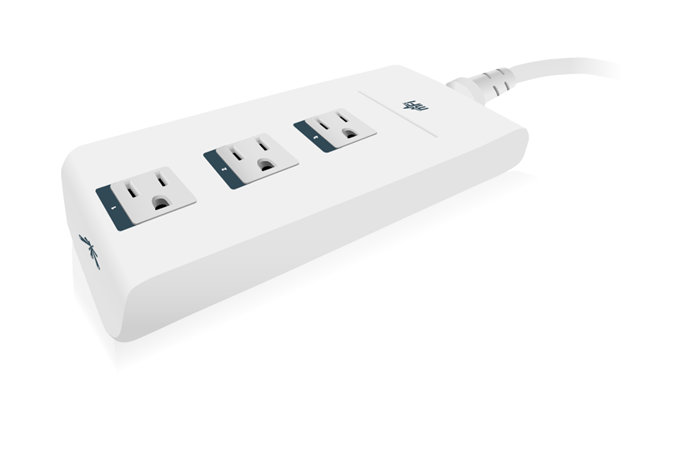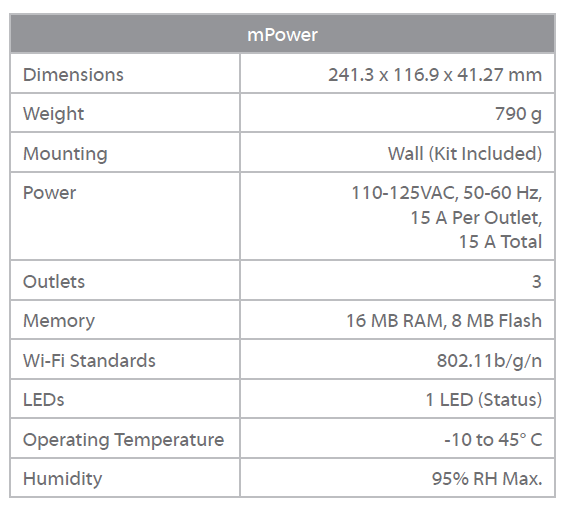Ubiquiti Networks mFi mPower Wi-Fi Power Strip Review
by Ganesh T S on November 21, 2013 3:00 AM EST- Posted in
- Home Automation
- Wi-Fi
- Ubiquiti Networks
- IoT

Introduction
The Internet of Things (IoT) revolution is happening right now. As smartphones proliferate, consumers want the ability to control devices in an automated and easy manner. Remotely switching a power outlet is one of the basic building blocks of an automation system (home or business building). Last year, we reviewed Visible Energy's UFO Power Center, a standalone device which combined energy awareness and home automation in a striking package. Today, we are looking at Ubiquiti's mPower mFi power strip. This is a device with similar features (ability to turn on/off an outlet over a wireless network and measure the power consumed by a device connected to an outlet). However, it caters to a very different market segment.
Ubiquiti Networks - Background
Ubiquiti Networks started off as a manufacturer of wireless products for enterprises, aiming mainly at emerging markets. We have generally found that their kits cost much lower than the competition (and it is attributed mainly to the fact that they don't employ a dedicated sales / marketing team). A couple of years ago, Ubiquiti started looking into expanding their product portfolio. One of the under-served product categories amongst businesses (Ubiquiti's target customers) is that of building automation. As home automation picks up steam, building automation (a term that I will use to talk about home automation technologies from the perspective of an office building) can be expected to follow. Ubiquiti launched the mFi product category to catch this wave. Ubiquiti calls the mFi as the reinvention of machine-to-machine (M2M) communication.
mFi - A Platform for Building Automation
The mFi product category consists of three main products, the mPort, mPort Serial and mPower. A number of sensors (under the mSensor category) are also included, and these interface with the mPort units through a Cat 5 cable. These include door sensors, motion detectors (both wall and ceiling varieties), temperature and current sensors. The mPort Serial provides a remote serial connection for any other devices controllable through a serial interface. Control of multiple such devices is integrated in a management software called mFi. Written in Java, it is compatible with multiple platforms.
Introducing the mPower
The product we are going to cover in detail today is the mPower. It comes in three variants, all of which support connection to a Wi-Fi network. The fundamental difference is in the number of switchable outlets. The mPower Mini has one, the mPower has three and the mPower Pro has eight. The mPower Pro also has a wired network port. Simply put, the mPower units allow the outlets to be turned on / off over the network using the mFi management software as well as a web interface. Essential statistics about each outlet (VRMS, IRMS, power factor and active power) are also reported through both avenues.
The mPower retails for around $60. The mFi controller software is bundled free with the unit. The mPower Pro (8-outlet version) retails for around $100, which represents better value per outlet. However, the Pro units were not easy to source since Ubiquiti had some supply constraints. Ubiquiti's products are not present in the usual retail channels. Instead, they are sold by B2B vendors (who sometimes have a presence on Amazon). The specifications of the mPower, as provided by Ubiquiti, are presented in the table below.

In the remainder of this piece, we will look at the setup and usage impressions, followed by details of the mPower platform. We will also present one of our custom applications developed for the mPower, thanks to its open platform. This will be followed by a few concluding remarks summarizing the pros and cons of the unit.










61 Comments
View All Comments
easp - Thursday, November 21, 2013 - link
I'm intrigued by it for controlling some relatively dumb devices that draw a lot of power, like space heaters, a dehumidifier and a floor-standing AC unit. With this, a cheap wireless weather and temp/humidity system I've already hacked, and a few scripts, I could easily start controlling things based on things like presence, differences between indoor and outdoor temps, etc.That obviously isn't something your average person is going to do, but it isn't hard to imagine that sort of thing becoming turn-key.
bznotins - Thursday, November 21, 2013 - link
When my home server (which I use as my personal cloud) hard-locks when I'm on the road, it would be nice to power-cycle it remotely. This will let me do that, so I ordered it.Sample size of one, but there are people that can use this kind of device.
jason32 - Friday, November 22, 2013 - link
Why is your server crashing like that and often enough for you to consider getting the mPower? You should probably fix that first before looking into the last resort power cycling solution.bznotins - Wednesday, November 27, 2013 - link
It only does it about once a month. Pretty hard to diagnose.But that once a month always seems to be when I'm on the road and can't power-cycle it in-person?
Is this power strip a panacea? No. But my point is that there is a use for it.
azazel1024 - Thursday, November 21, 2013 - link
I feel like an important piece of information is missing. How much does the mFi mPower ITSELF user in terms of power. It sounds interesting and I certainly have tons of ideas on how I could use it (or other could). However, a large part of that would be power savings.If the thing burns 5w of power though...that just might tip it from possibly saving power in some usage scenarios to burning more power than it saves.
ganeshts - Sunday, November 24, 2013 - link
I will update the article shortly.. It consumes slightly less than 1W when idle.samsp99 - Thursday, November 21, 2013 - link
Last weekend I found a similar product from quirky at home depot. In conjunction with GE they have a line of wifi connected products, including a sensor, egg monitor, guage dashboard, and a power strip with two outlets that can be remotely switched from an iOS or Android device.The cool thing is to program them you "blink" them by holding a smartphone screen against a sensor that detects a flashing sequence on the screen. This is based on tech from Electric Imp which developed the chipset and has a developer kit and SDK for building your own devices.
I bought the power strip for fun, but with an eye to controlling the xmas lights, so I can have them on a timer, but also switch on and off on demand.
Kurge - Thursday, November 21, 2013 - link
Might be moderately interesting if it support Vera. Would be even more interesting if it was a standard power outlet that fits in a normal box.As it stands - meh.
drizzo4shizzo - Thursday, November 21, 2013 - link
Don't plug your wifi router into it...nekoken - Thursday, November 21, 2013 - link
According to your screenshot this device has 32MB of ram, not 16.I may have to buy one or more of these. This looks like a good way to kick my children off of specific electronic devices remotely. ssh in and BAM!